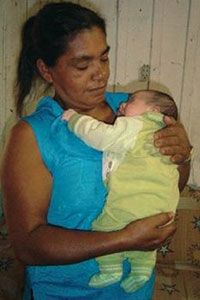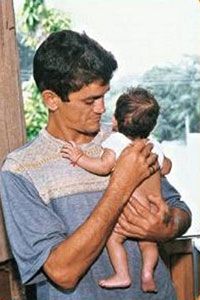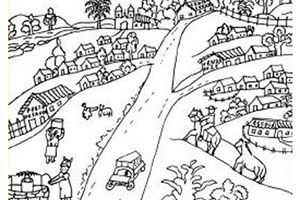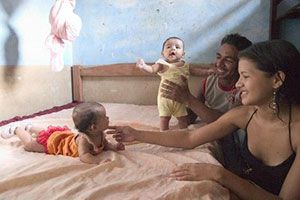
Foto:
To assess and celebrate
How was the visit to the baby?
• Did you have the chance to observe the baby being breastfed? How was the sucking position of the baby?
• Has the mother told of any difficulty in this period?
• Share the ideas you had to encourage breastfeeding.
• Is there any message, pray or a biblical quotation which celebrates the gift of life and the actions that we have performed with our next?
To See
The baby in the first month
1. What do the mothers of your community give the baby to eat in this age?
2. Who do the mothers of your community talk to when they have difficulties to breastfeed?
While breastfeeding, is there any eye contact and ex
Breastfeeding is very important to the mother and to the baby. Besides the baby receiving food specially made for him, this is the moment they are more connected to each other.
The eye contact and exchange of affection during breastfeeding strengthens the bond between the mother and her baby. In each breastfeeding the baby and the mother get to know and to love more each other. Therefore, it is important that you observe how the mother and the baby are connecting during breastfeeding.
Tell the mother that, when the baby looks at her while sucking, he/she will feel happy if she also looks at him/her. And this is very good for both. Try to encourage the mother to always talk to the baby, caress the baby’ body and to look at him/her while she feeds him/her.
Until the sixth month, the baby only needs to suck milk from the breast. It is good to explain to the mother that powdered milk does not have the same advantages of the mother’s milk.
The babies who are fed with other types of milk run more risks of having pneumonia, diahrrea, ear infection, allergy and urine infection. Apart from the fact that babies suffer more from those diseases, these also come stronger and more severe. This happens because the defences of the baby’s body are not strengthened with the protection that the mother’s milk provides.
Offer other food or liquids to the baby before the sixth month of age increases the chances of him/her to abandon the mother’s milk. This does not bring any benefit to the child’s growth.
When the baby receives liquid or food, lots of care with the hygiene in their preparation shall be taken and also with the vessels and spoons used to serve the food to the baby.
“Whatever house you enter, let your first words be, "Peace to this house!" Luk 10: 5
How the baby can learn and grow

Foto:
Every new day the parents get to know the baby better. The baby is very attached to the mother. She is the source of the baby’s safety and love. He/she likes to stay in her lap and to be rocked by her. When the mother puts the baby close to her heart he/she listens again the heart beats that he/she knows so well. Thus, the baby remembers the feelings he/she had while was still in the mother’s belly. All this helps the baby to become calmer and safer
The baby also likes to listen to the voice of the father. When the mother and the father speak or sing sweetly they show the baby that he/she is loved.

Foto:
Does the baby get calm when he/she hears the voice of the parents, is touched or rocked
The lap meets the need of contact of the baby with the parents and it is a love demonstration. If the baby is feeling some discomfort, agitated or crying, he/she gets calmer when the parents hold him close to themselves, speak, sing or rock him/her gently. Each baby has a different way to get quietened.
The cry is a communication means of the baby. To hold the baby and check why he/she does not cry does not create a bad habit. The baby who does not receive attention when he/she cries, usually cries more than usual. The baby who receives prompt attention feels that someone takes care of him/her and gets calmer.

Foto:
The vision and hearing of the baby are still improving but he/she listens and sees partially what happens around him/her. It is common the baby is a little asquint till the sixth month.
The baby needs his/her own place to sleep, preferably calm and airy. If the house is located in a place with mosquito it is recommended that the cradle the baby sleeps is covered with a curtain.
The best position for the baby to sleep is on his/her back. To avoid suffocation it is good to raise a little the headboard so that the baby has the head a little more raised than the body.
It is good for the baby to take some sun everyday before nine o’clock or after four o’clock’. At these times the sun is a source of health.
Attention: The chance for the baby to die suffocated is bigger when he/she sleeps in the parent’s bed.
Hygiene

Foto:
The baby needs to take a bath everyday. In hot weather places it is possible to give the bath several times a day. In cold weather places, the best time is to give the bath in the warmer hours of the day protecting the baby from the wind to avoid her /him to get a cold.
The clothes and diapers of the baby need to be well washed, rinsed and, whenever possible, put under the sun to dry. The better is to wash them separately. All this helps to prevent galls, allergies and infections in the baby skin.
The baby feels colder than the adult. Therefore it is good that he/she is dressed with light clothes even in hot weather places. In the cold places it is important to keep the baby well covered.
Attention: the baby who gets the feet, hands and lips purple after being fed, even though he/she is well covered may have some heart problem and needs to be examined by the doctor as soon as possible.
Vaccines

When the baby completes the first month of age, he/she should take the second vaccine against Hepatitis B.
Hepatitis B is an inflammation in the liver caused by a virus. It is a disease, which may cause serious complications such as the liver cancer and cirrhosis. This is why the mothers should be instructed to take the children to receive the right doses of this vaccine.
If the dose of BCG vaccine has not been taken in the maternity, the baby shall take this vaccine on the same day appointed for the second vaccine against Hepatitis B.
Organizing the leader’s activity

Foto:
The Child’s Pastoral is based on the Gospel of the loaves and fish multiplication applied to start and organize the work in the communities.
1. The Gospel of Saint Mark (Mar 6, 30-31) tells us that Jesus listened to everything the apostles had done and taught:
• Leader, how do you feel working in the Child’s Pastoral?
2. In this same Gospel, Jesus proposes that the apostles rest a little. They left to a desert place, alone. But the multitude remains behind, for they were like sheep without the shepherd:
• Leader, how many children and pregnant women of your community need the Child’s Pastoral?
3. The disciples would like that Jesus sent the multitude away to seek for shelter and food, but Jesus orders them: “Give them something to eat yourselves.”
• How to face the challenge that Jesus makes us today of being responsible for taking a full life to all the children and pregnant women in our community?
4. Jesus asked the disciples: “Where can we buy some bread for these people to eat?”. One of Jesus’ disciple said: “Here is a small boy with five barley loaves and two fish; but what is that among so many? ”(Joh 6:8-9):
Which resources we have in our communities? (Health Service, schools, churches, neighbourhood associations, etc…) Which people can help us in our mission? Is this enough to meet the needs of the people in our community?
5. Jesus then, asked the disciples to organize the people in small groups for the meal: And we, how can we organize our community in small family groups for each leader?
6. Then Jesus took the loaves and the fish, pronounced the blessing, shared the bread and the fish and gave to the disciples to be distributed: How do we share our gifts, our time, knowledge, life experience and love with our next?
7. Everybody ate and became full and a lot of the food was still left: We believe that with the little we have, when shared with the blessing of Jesus it becomes a lot. How do we know if what we share is helping to search for a full life to all the children and the pregnant women?

Foto:
To organize the families, it is important that the leaders make the mapping of the community; that is, identify who are and where the families with the pregnant women and children till six years of age live. After that, it is necessary that they organize, per leader, the family groups which will be followed.
When there are many families, it is necessary, at a first moment, to assist the children who are most needy. For example: the families who have pregnant women, younger or sick children. After that, the area coordinator, with the assistance of the leaders already qualified and acting, should look for other leaders to be able to follow all the families identified in the community.
'Which one of you with a hundred sheep, if he lost one, would fail to leave the ninety-nine in the desert and go after the missing one till he found it? Luk 15:4
Jesus asked his disciples to see if all the community was fed. It is also necessary to see if all the pregnant women, children and families followed, are managing to improve their life situation. To assess the work performed the Child’s Pastoral uses the indicators of the Leader’s Notebook.
It is Jesus miracle repeating itself nowadays!
Promoting a favourable environment for the child development

Foto:
When we speak of development, we are speaking of changes. These changes become possible through the care, attention, relationships and activities which are provided since the child’s conception and they continue for the whole life of a person.
The adults, in the family and in the community, are responsible for generating a favourable environment to the child; that is, they shall provide conditions and opportunities for the child to develop.
Each child develops on his own way, that is, each child has his own way of responding to the conditions and to the opportunities he/she receives.
Even the child who is born with a difference in his/her body – for example – a deaf child – has his/her own way to develop. The leader can help the family to accept and understand that the development of this child will be different, but that he/she has the right, like every child, to the opportunities to learn and develop.
Indicators to follow up the child

Foto:
In order to develop, a child has to live in a favourable environment. In order to support building up and organizing this environment, the Child’s Pastoral has indicators about Health and others which are called Opportunities and Achievement Indicators.
The health indicators refer to breastfeeding, weight, diahrrea, vaccinations and access to health services.
The indicators of opportunities and achievements are designed to show if the child lives situations, which promote his/her development in the family and in the community. The opportunities should allow the child to reach achievements, that is, learn new skills and develop.
In fact, what makes a child grow and develop are the cares with his/her health, the love, the attention and the participation in the activities with his/her family and in his/her community. Therefore, if we want to follow and promote the child’s development, it is important to observe how is her/his life condition.
The Child’s Registration
Leader, as soon as the baby is born visit him/her and register him in the same follow up sheet where his/her mother’s data are registered.
In the letterhead are found the questions number 1, 2, 27, and 28, which you should answer as soon as the baby is registered or when a new notebook is started, or when the baby is out of the Pastoral.
Questions numbered 5 to 18 are about the child’s development, and you are going to answer them every month, according to the age of the child followed.

Indicators of opportunities and achievements

Foto:
The first indicator of opportunities and achievements appears on page 106 of this guide. Those indicators are organized in eight age ranges, which start in the baby’s first month of life and continue till the child reaches six years old. In each age range four indicators are filled in.
Those indicators are designed to value and stimulate attitudes in the family and in the community which promote the development of the child. They do not serve to assess the child’s development. They are, mainly, a short talk to the family, a way to begin and keep a dialogue. Through those talks, you, leader, should identify and think together with the parents which family routine situations may become the opportunities the child needs for his/her development.
INDICATORS OF OPPORTUNITIES AND ACHIEVEMENTS
Leader, talk to and ask the child’s family who completes this month:
1 month
Does the baby have birthdate certificate? (page 106)
Does anyone help with the housekeeping so the mother can take care of the baby? (page 108)
While breastfeeding, is there any eye contact and exchange of tenderness between the mother and the baby? (page 129)
Does the baby calm down when he/she hears the parents' voice, when is touched or is rocked? (page 132)
2 and 3 months
When the mother or the father smiles to the baby, does he/she respond with another smile? (page 150)
When the mother or the father moves the face slowly before the baby, does he/she follow this movement? (page 151)
When the parents lay the baby on his tummy, does he/she raise the head and the shoulders, supporting him/herself on his/her arms? (page 152)
Do the parents take the baby in the lap to caress, speak and play, even when the baby is not crying? (page 153)
4 and 5 months
Does the baby show he/she identifies the people who are always with him/her? (page 173)
When someone makes noise behind the baby, does he/she turn the head around searching for the noise? (page 174)
Do the parents encourage the baby to try to catch the things that are put close to him/her? (page 175)
When someone puts the baby to sit with support, can he/she stay in that position? (page 176)
6 to 8 months
Do the parents or who always take care of the baby give opportunity for him/her to relate to other people? (page 198)
Do the family members encourage the baby to play with objects? (page 199)
Does the baby catch objects and play with them beating, throwing and tearing them off? (page 200)
Do the family members communicate with the baby of several ways, using sounds, gestures, words? (page 201)
9 to 11 months
Does the baby use gestures to communicate: pointing, clapping hands and giving good-bye? (page 213)
Do the family members say the objects’ name and speak about the activities they do with the baby? (page 214)
Do the family members arrange space for the baby to learn to move on his own? (page 215)
Does the baby walk with support? (page 216)
1 year to 1 year and 11 months old (12 months to 23 months)
Do the family members speak and talk to the child? (page 231)
Does the child understand when the people ask something to him/her? (page 232)
Does the child communicate using small phrases? (page 238)
Does the child have a safe space to walk, run and play? (page 241)
2 years to 3 years and 11 months old (24 months to 47 months)
Do the family members encourage the child to play and do they play with him/her? (page 250)
Do the family members teach, with no violence, what the child cannot do? (page 254)
Does the child play make believe? (page 259)
Does the child have the opportunity
to play with other children? (page 261)
4 years to 5 years and 11 months old (48 months to 71 months)
Do the family members have the opportunity to read to the child? (page 273)
Do the family members give value and encourage the child to draw? (page 274)
Do the family members show or invite the child to participate in their activities? (page 275)
Does the child attend the kindergarten? (page 278)
In the Leader’s Notebook there is the question:
13. Which indicators of opportunities and achievements were reached this month?
Question 13 is answered with the help of the indicators that are placed on the edge of the cover of the Leader’s Notebook as well as in this Guide. According to the age of the child, talk about the indicators to the mother or to the one who takes care of him/her. In each of the squares of question 13, write down:
1. [Y] (yes) if the indicator was reached; 2. [N] (no) if the indicator was not reached; 3. [?] (question mark) if you had doubt or were not able to observe the indicator.
If there is any difference between your observation and the answer of the mother or of the person that takes care of the baby, write down [?] (question mark).
In the answers to the Indicators of Opportunities and Achievements it is necessary to take into consideration that each family has its own way of taking care and raising the children and each child has his/her own way and time to develop.

When the answer to an indicator is [N] (no), it is always necessary to investigate.
The answer may indicate, for example, that it is necessary to create the opportunities described in the indicators, and that are not part of the family’s routine yet. For example, in the case of a baby of six months old, when the indicator was not reached “the people of the family encourage the baby to play with the objects? “ you leader, by talking to the parents, can investigate to know what is happening and then think about a way to help them.

Does the family have any objects for the baby to play with? Does the family know that it is important to offer objects to the baby?
When the opportunities exist, the majority of children reach the achievements pointed out in the indicators in the end of each age range.
The answer [N] (no) to an indicator referring to an opportunity and achievement may mean, at the same time, that either the child has not had the opportunity or that the child is still achieving the skill. That is the case, for example, of the indicator: “ When someone puts the baby to seat with a support, can the baby remain in this position”?

Another situation is when the child has a different way to manifest his/her achievements due, for example, to her/his difference functioning of the body – for example – the case of a deaf child. In this case, the response to the indicators related directly to the hearing would be [N] (no). One explanation for these cases shall be seen on page 281.
It is needed much attention when one indicator has not been reached till the end of the age range; that is, continue to have the answer [N] (no). In this case, it is necessary to watch the child and guide the parents the following months. It is also important that you, leader, check with the area coordinator what else can be done.
The purpose of the indicators is to show the leader when the family needs more assistance.
End of postnatal (puerperium)
The mother should go back to hospital to do a check, according to the appointment made on the date she left the hospital.
This check should be made until one moth after the childbirth. It is good that the partner accompanies the mother. Thus they both can receive guidance about the space between pregnancies.
The postnatal period lasts for forty days. When the wife is well, the couple can have sexual intercourse again soon after this period.
The doctor should prescribe Iron for the mother until the child reaches 3 months.

Home Visit
In these visits, it is important:
Observe the baby being fed and if he/she is put in the right sucking position (see page 112)
Insist with the mother about breastfeeding as the sole feeding way.
Talk about the signs of danger (page 126).
Observe and talk to the father and the mother about the indicators of Opportunities and Achievements
Answer the questions of the Leaders’ Notebook
Task suggestion for this qualification stage:
Organize a mapping of the community.
Try to identify where the pregnant women are and, at least, three babies younger than one year old.



